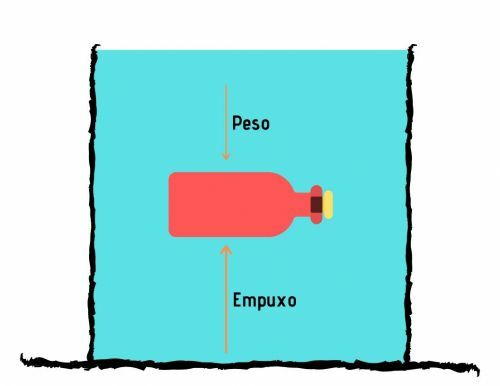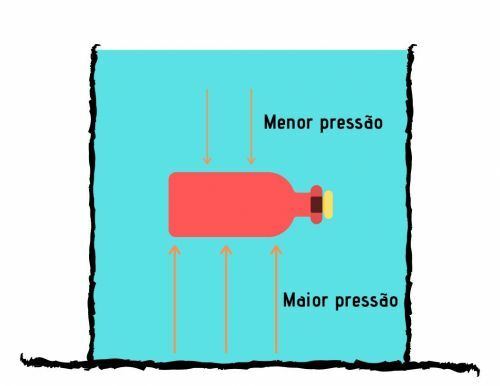thrust is the force a fluid exerts on a submerged body. This force has a vertical and upward direction and corresponds to the weight of the volume of liquid that has been displaced by the object.

The existence of this force explains the fluctuation of bodies in water, such as large icebergs or ships, and also the feeling that objects in the water appear to be lighter than they really are.
This phenomenon was first explained by the Greek physicist Archimedes (287 a. C - 212 a. C), who had been commissioned by the king to check whether his crown was made of pure gold or had other elements mixed together. For this reason, thrust is also called Archimedes' Principle.
See the statement of this principle:
Every body immersed in a liquid experiences a force called buoyancy, which corresponds to the weight of the volume of liquid displaced.
According to some stories, Archimedes was taking a bath when he came to the conclusion that the water exerted a force on his body. Upon making such a statement, the physicist went screaming through the streets
"eureka, eureka!", which in Greek means "discovered".know more about Eureka.
How does the thrust happen?
When a body is submerged, fluid exerts pressure on it. The pressure exerted on the bottom will always be greater than the pressure exerted on the top, because the greater the depth, the greater the pressure. See the image below:

So we have to thrust is a result of the pressure difference between the bottom and the top of the object. and it happens from the bottom to the top due to the increased pressure at the bottom of the submerged object.
thrust formula
The value of the thrust will be equal to the weight of the volume of liquid displaced, that is:
E = PDES
Considering that weight is equal to the product of mass and gravity (P = m.g), we have:
E = mDES. g
Density being the ratio between mass and volume (d = m/v), the buoyancy formula is:
E = dF. VDES. g
Where:
- E = thrust
- dF = fluid density (kg/m3)
- VFD = volume of fluid displaced (m3)
- g = gravity acceleration (m/s2)
From this formula we can conclude that the buoyancy depends on the density of the fluid, the volume of fluid displaced and the acceleration due to gravity.
Although the pressure is greater as the depth increases, buoyancy does not increase as the object moves farther to the bottom, this is because the pressure on the bottom and top of the object increase in the same measure.
Also understand what they are volume measurements.
apparent weight
When a body is submerged in a fluid, there are two forces acting on it: weight and buoyancy. Weight is a force exerted vertically and from top to bottom. Buoyancy is the force exerted vertically from the bottom up.
The action of these two forces makes the weight of a body submerged in a fluid appear smaller, which we call apparent weight. The apparent weight is calculated by subtracting the thrust from the actual weight:
PTHE = P - E
Floating bodies
Density is the property that allows bodies to float or sink, see the possibilities:
- Body density greater than fluid density: the body will sink.
- Body density less than fluid density: the body will float.
- Body density equal to fluid density: body is immersed and in balance.
Note: It is important to note that buoyancy depends on fluid density, not object density.
know more about density.
icebergs
The fluctuation of icebergs is an interesting phenomenon to understand the different densities. Ice floats on water because of its lower density than liquid water. In liquid state the density of sea water is 1.03 kg/l and ice is 0.92 kg/l.
As the difference between densities is small, most of the iceberg remains submerged, only about 10% of its body is out of the water.
See also the meaning of the Newton's laws, strength and iceberg.

